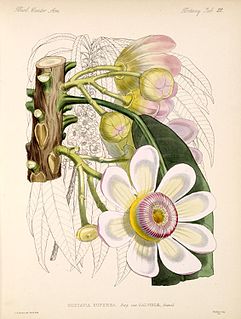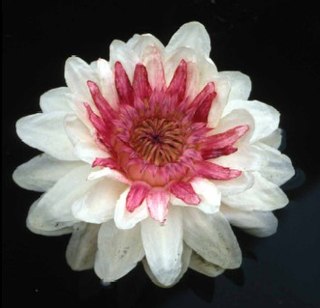
The Lecythidaceae comprise a family of about 20 genera and 250–300 species of woody plants native to tropical South America, Africa, Asia and Australia.
Gustavia excelsa is a species of woody plant in the family Lecythidaceae. It is found only in Colombia.
Gustavia foliosa is a species of woody plant in the family Lecythidaceae. It is found in Colombia and Ecuador.
Gustavia fosteri, one of several plants in the genus Gustavia known by the Spanish common name membrillo, is a species of woody plant in the family Lecythidaceae. It is found only on Barro Colorado Island in Panama. It is threatened by habitat loss.

Gustavia gracillima is a species of woody plant in the family Lecythidaceae. It is found only in Colombia.
Gustavia latifolia is a species of woody plant in the family Lecythidaceae. It is found only in Colombia.
Gustavia longepetiolata is a species of woody plant in the family Lecythidaceae. It is found only in Brazil. It is threatened by habitat loss.
Gustavia monocaulis is a species of woody plant in the family Lecythidaceae. It is found in Colombia and Panama. It is threatened by habitat loss.
Gustavia pubescens is a species of woody plant in the family Lecythidaceae. It is found in Colombia and Ecuador.
Gustavia santanderiensis is a species of woody plant in the family Lecythidaceae. It is found in Brazil and Colombia. It is threatened by habitat loss.
Gustavia sessilis is a species of woody plant in the family Lecythidaceae. It is found only in Colombia.
Gustavia verticillata is a species of woody plant in the family Lecythidaceae. It is found in Colombia and Panama.

Gustavia is a genus of flowering plants in the family Lecythidaceae described by Linnaeus in 1775. It is native to tropical Central America and South America. Many of the species are threatened; some are critically endangered Gustavia superba, though, is actually abundant in re-growing secondary forests. It grows in northern South America, from Panama south through the Andes as far as Ecuador, and along the Caribbean coast and in the Amazon basin. Gustavia flowers have numerous stamens, in some species as many as 1,200 in a single flower.
Membrillo is a Spanish language common name for several species of plants:

The Flora of Colombia is characterized by 130,000 species of plants that have been described within Colombian territory.
Carmenta haematica, the Argentine root borer, is a moth of the family Sesiidae. It was described by Ureta in 1956, and is known from Argentina and Chile.
Carmenta theobromae, the cocoa fruit borer, is a moth of the family Sesiidae. It was described by August Busck in 1910, and is known from Colombia and Venezuela.
Carmenta surinamensis is a moth of the family Sesiidae. It was described by Heinrich Benno Möschler in 1878, and is known from Brazil, Surinam, Guyana, Trinidad, Panama and Costa Rica. The larvae of the species have been found on seeds of the plant Prioria copaifera, Pentaclethra macroloba, and plants in the genus Mora.
Gustavia angustifolia is a small tree, native to South America, with large white flowers. It is an endangered species.



